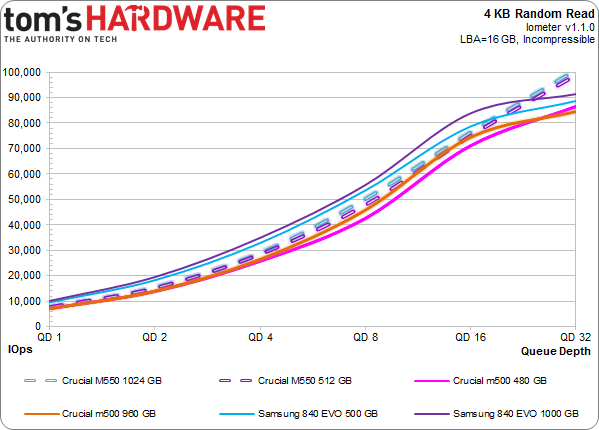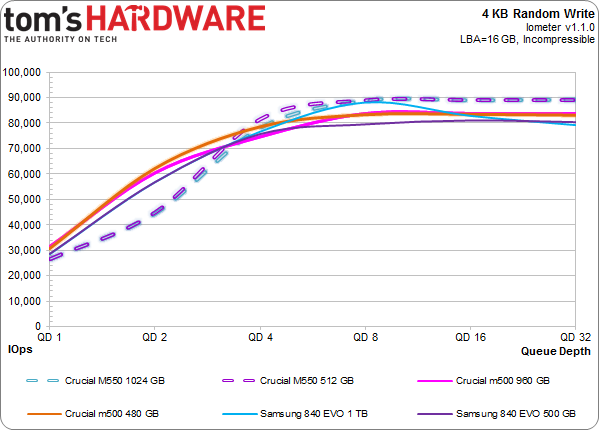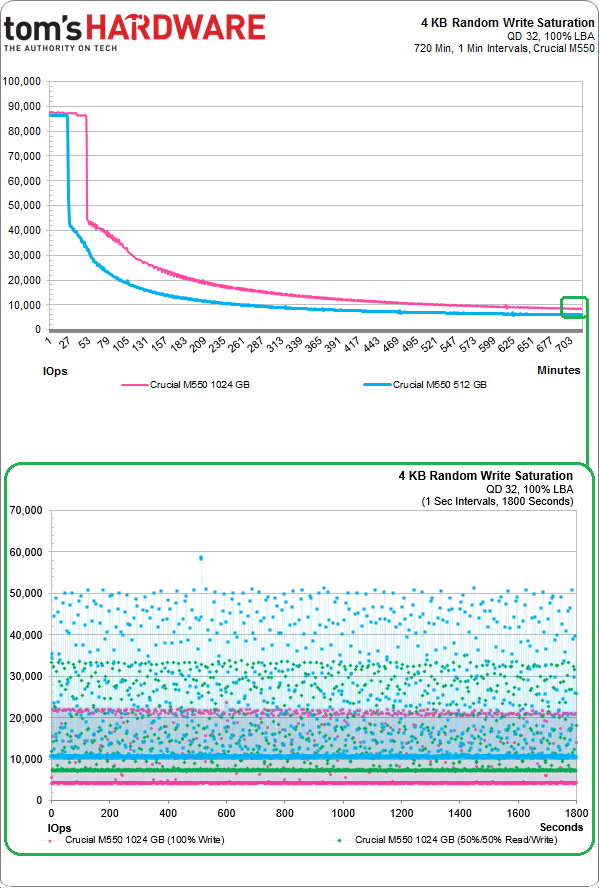The Crucial M550 SSD Review: Striking Back With More Performance
Crucial's M500 brought mainstream performance, enhanced features, and rock-bottom pricing together in one of the most-recommended SSDs of 2013. Following up, Crucial has a refined version called the M550, juiced-up for performance-hungry enthusiasts.
Results: Random Performance
We turn to Iometer as our synthetic metric of choice for testing 4 KB random performance. Technically, "random" translates to a consecutive access that occurs more than one sector away. On a mechanical hard disk, this can lead to significant latencies that hammer performance. Spinning media simply handles sequential accesses much better than random ones, since the heads don't have to be physically repositioned. With SSDs, the random/sequential access distinction is much less relevant. Data are put wherever the controller wants it, so the idea that the operating system sees one piece of information next to another is mostly just an illusion.
4 KB Random Reads
Testing the performance of SSDs often emphasizes 4 KB random reads, and for good reason. Most system accesses are both small and random. Moreover, read performance is arguably more important than writes when you're talking about typical client workloads.
Samsung's 840 EVOs are unmatched in random reads at a queue depth of one. The fastest model achieves more than 10,000 IOPS. Crucial's new drives aren't as proficient with a single outstanding command, measuring less than 8000 IOPS. In comparison, the M500 registers about 7000 IOPS at a queue depth of one.
At the other end of our chart, Crucial's 1024 MB M550 delivers 100,000 IOPS with 32 outstanding commands. That's 1000 more than the 840 Pro, and right on par with SanDisk's PCI Express-based A110. Hitting 100,000 IOPS doesn't mean much of course, particularly on a desktop. Still, it's a nifty achievement. And the 512 GB M550 shows its mettle by keeping within ~1% of the larger drive's peak finish.
4 KB Random Writes
Random write performance is also important. Early SSDs didn't do well in this discipline, seizing up even in light workloads. Newer SSDs wield more than 100x the performance of drives from 2007, though we also recognize that there's a point of diminishing returns in desktop environments.
Get Tom's Hardware's best news and in-depth reviews, straight to your inbox.
Both M550s start off a little slower than the competition at queue depths through four. Then, they both sit atop the other SSDs we're comparing them to.
Random Performance Over Time
My saturation test consists of writing to each drive for a specific duration with a defined workload. Technically, it's an enterprise-class benchmark, where the entire LBA space of the SSD is utilized by a random write at high queue depths.
Here's 12 hours of a 4 KB write with 32 outstanding commands. First, we secure erase each drive. Then we apply the 4 KB write load, showing the average IOPS for each minute (except for the last 20 minutes, where we zoom in and show you one-second average increments).
After the first drive fill, performance drops off fast, since the SSD no longer has free blocks to write to. Instead, they have to be erased prior to subsequent writes.
The top section of this graph represents both M550s writing across the entire span with a queue depth of 32 for 720 minutes. That's enough time to show both SSDs hitting their steady state performance level.
Both capacities are capable of similar performance right out of the box (just under 90,000 IOPS, according to my test). So, the 1024 GB model, with twice as much capacity and the same performance, takes two times as long to fill the first time around. After that, the drives drop into steady state after several hours, where they both settle in the 7000 IOPS range. Not bad for an architecture with 7% spare area and no additional over-provisioning.
Zooming in to a 30-minute log in one-second intervals of steady state performance tells us even more. The bottom half of the chart shows 100% writes (in pink), a split between reads and writes (in green), and a mixed workload of 30% writes and 70% reads (shown in blue). Unlike the last drive we reviewed, Intel's SSD 730 480 GB, Crucial's M550s are all over the map. The SSD 730's enterprise background contributes to its consistent performance. Meanwhile, the M550s doesn't bother with steady state QoS. This is a consumer-oriented drive, though. If it takes 12 hours of writing 4 KB chunks to get to this point, you'll never see the same behavior on you desktop. And while we're using the raw block device with no partition, Windows uses files and the TRIM command.
Here's a breakdown of the maximum observed 4 KB sequential read and write performance with Iometer. The order the drives appear in our chart is determined by maximum combined read and write performance.
Thanks to stellar specifications translating into better performance on the bench, Crucial's M550s boast the highest combined read and write IOPS.
Current page: Results: Random Performance
Prev Page Results: Sequential Performance Next Page Results: Tom's Storage Bench v 1.0-
ikyung Heard rumors of Samsung planning to market the 850 with aggressive pricing this year. Would like to see Crucial and Samsung duke it out in pricing.Reply -
cryan ReplyHeard rumors of Samsung planning to market the 850 with aggressive pricing this year. Would like to see Crucial and Samsung duke it out in pricing.
They already have IMHO. The Samsung 840 EVO is significantly cheaper than it was at launch. It and the M500 have seemed to move in lockstep. Along the way, we've seen other manufacturers follow suit. Even Intel's 530 series, which has been on the more expensive side of mainstream products has been seen for just $140 for the 240 GB version here in the State.Regards,Christopher Ryan -
venk90 INSANELY GOOD DEAL ON AMAZON ! The 512 GB SSD is listed at 169$ incorrectly ! Grab them before they change it. I ordered 20 myself ! Will e-bay all of it or feel bad and return it to Amazon !Reply -
cryan ReplyI just splashed $250 (delivered to Oz) on a M500 480GB mSATA, eh, can't complain.
I hope Crucial continues to sell the M500 right where it is. The deals are just too good, and it'd be truly sad were Crucial/Micron to up the price on us.And they're not slow. I know it seems like they're sub par compared to some of the last few drives we've tested, but the reality is most users are never going to notice the speeds between different SSD models. The only exception is jumping from an older SATA II drive to a modern SATA III SSD. Even then, you'd need solid hardware in the system.Regards,Christopher Ryan -
Ankursh287 M500 available at $240 (amazon)..damn good drive for the price, performance difference between M500 , M550 & 840/840 pro won't visible to normal user.Reply -
Nada190 When I look at SSD's I want price to performance because I won't even notice a difference.Reply -
Drejeck Specifically for gaming which would be the best? All sort of tricks are allowed, from tweaks to samsung's magician (ram caching).Reply -
RedJaron ReplyOf course, we're in the throes of post-launch pricing. In a few weeks, it's possible that the gap between M500 and M500 will narrow.
Typo on the last page. One of those should be 550.
Happy to see Crucial with this update. I'm with a lot of people, you don't see a difference in SSD performance outside benchmarks. Give me something reasonably fast with great durability and I'm sold. With all this talk of the maturing of 20nm manufacturing, I'd love to see an M500 V2 with less overprovisioning.
-
gizmoguru Hay Tom's the chart for Sequential Reads Benchmark is labled "Random Writes", please correctReply



